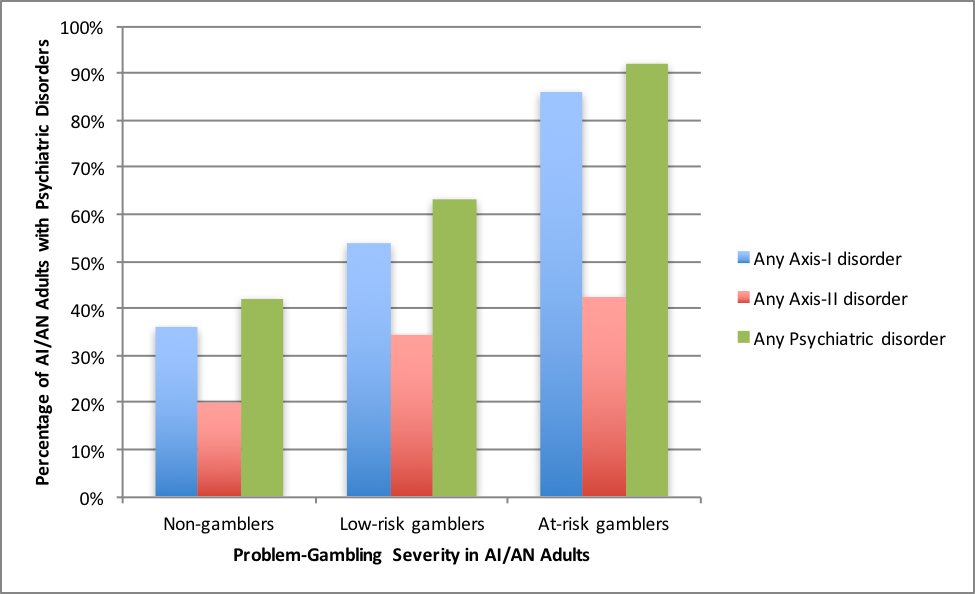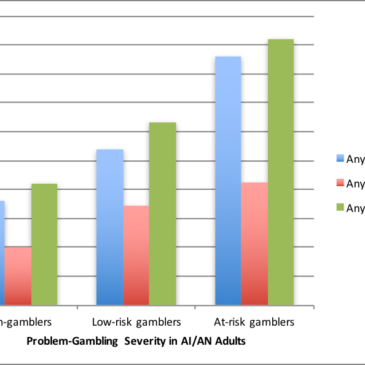Gambling disorder is a serious public health concern, and is often associated with money problems and worsened mental and physical health. Previous research has found higher rates of disordered gambling in American Indian/Alaska Native (AI/AN) populations, possibly related to similarly higher rates of mental illness and the complex relationship between US tribal communities and gambling facilities. Dr. Grace Kong and her colleagues used national survey data to examine the relationship between problem-gambling severity and prevalence of psychiatric disorders among AI/AN adults. This week, as part of our special series on Addiction, Resilience, and Recovery within Tribal Communities, The WAGER reviews their study.
What was the research question?
What associations exist between problem-gambling severity and psychiatric disorders among American-Indian and Alaskan-Native (AI/AN) populations?
What did the researchers do?
Kong and her colleagues analyzed data from Wave 1 (n = 43,093) of the National Epidemiologic Survey on Alcohol and Related Conditions (NESARC), conducted in 2001 – 2002. The NESARC included past-year measures of DSM-IV Axis-I (mood, anxiety, pathological gambling, and substance use disorders) and Axis-II disorders (personality disorders). Based on how participants responded to DSM-IV diagnostic criteria and questions about gambling, researchers categorized participants into three types of gamblers: (1) non-gambler (gambled 5 times or less a year), (2) low-risk gambler (endorsed 0-2 diagnostic criteria), or (3) at-risk gambler (endorsed 3 or more diagnostic criteria).
What did they find?
AI/AN adults had 20% increased odds of being a low-risk gambler versus a non-gambler, when compared to white/caucasian adults. They were not more likely to be at-risk gamblers. Looking just within AI/AN respondents, those who were classified as low-risk or at-risk gamblers had 2.6 and 14.2 times greater odds, respectively, of having any psychiatric disorder, compared to non-gamblers (see Figure 1).1 The researchers found a similar pattern among other American adults.

Figure. The prevalence of psychiatric disorders across AI/AN non-gamblers, low-risk gamblers, and at-risk gamblers. Click image to enlarge.
Why do these findings matter?
For AI/AN adults, even low-risk gambling was associated with an increased likelihood of experiencing a past-year psychiatric disorder. Those who are at risk might need additional screening and treatment options. Additionally, when developing and implementing intervention strategies, it is crucial to address not only the historical trauma endured by AI/AN individuals, but also the continued systematic racism and oppression they face today. For example, the Historical Trauma and Unresolved Grief Intervention was developed as a four-day group training and healing intervention aimed at addressing historically unresolved grief in the Lakota tribal community. By integrating Lakota identity and traditional healing practices, the intervention helped participants, in the short-term, reduce their emotional distress and resolve their historical grief.
Every study has limitations. What were the limitations in this study?
These results represent AI/AN individuals in the US as a homogenous population, when in reality they represent over 500 federally-recognized tribes. Additionally, the researchers were unable to examine how living on or off a reservation would impact these findings.
For more information:
Find the original publication abstract here. If gambling is negatively affecting your life or others, please visit our First Steps to Change website. For access to mental health and substance abuse treatment programs aimed at tribal communities, you can check out the Indian Health Service’s resources or SAMHSA’s research and outreach.
— Layne Keating
What do you think? Please use the comment link below to provide feedback on this article.
________________
1Researchers controlled for age, gender, marital status, education, and income status.




